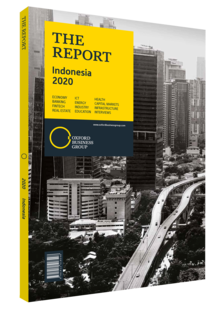How will data sharing boost oil output in Indonesia?
Oil production has been in steady decline for much of the past two decades in Indonesia, but the state aims to reverse this trend and achieve a production target of 1m barrels per day (bpd) by 2030. This will require investment from both domestic and foreign players, with policymakers searching for the right mix of state control and commercial incentives to achieve this.
The upstream exploration required to boost production has been flagging, with the number of exploration wells dropping from 38 in 2017 to 21 in 2018. Global oil prices have been a factor, with the price of Brent crude falling in 2014, before rising steadily between 2016 and 2019, then dropping precipitously in 2020 as a result of the impact on demand of the Covid-19 pandemic. Speaking in October 2019 in Jakarta, John Karamoy, chairman of the Oil and Gas Companies Association, stated that to meet the government’s targets, hundreds of new wells would need to be drilled. Karamoy estimated that investment of $600m per year over a decade was needed to reach 1m bpd, based on the assumption that Indonesia’s well-studied geography is familiar to oil geologists, who might, therefore, have a higher success rate than in less familiar terrain. As a result, he predicted that there could be one oil discovery for every five holes drilled, against an average of one in eight in most other countries.
Relaxed Regulation
To realise its oil production targets, Indonesia is seeking to improve investment sentiment among foreign multinationals. Regulators have shown flexibility in their approach, announcing in late 2019 that they would reintroduce cost recovery-based production-sharing contracts (PSCs), which had ended with the move to gross-split PSCs in 2017. Under the cost-recovery mechanism, the government reimburses companies for upstream-related costs in exchange for a higher share of total earnings.
The government is also hoping that recent regulations to improve industry access to upstream data will stimulate private investment. Through the issuance of Ministry of Energy and Mineral Resources (MEMR) Regulation No. 17 in mid-2019, the government created the Energy and Mineral Resources Data and Information Technology Centre, as well as a system for the sharing and use of non-confidential oil and gas data. Fee-paying members will have full access to a range of non-confidential data from the oil and gas industry, while non-members will be entitled to general or basic data. The government also introduced two new tax incentives for foreign investors in 2019: waivers on value-added taxes incurred on goods used in exploration, and 100% deductions for outstanding land and building tax related to hydrocarbons projects.
Local Control
MEMR’s agreement to extend the ConocoPhillips and Repsol PSC for the Corridor natural gas block is also a positive sign. The existing deal was set to expire at the end of 2023, but has been extended to 2043. In several instances, Pertamina has been the beneficiary of decisions not to renew expiring licences for productive assets held by foreign investors. A total of 10 PSCs since 2015 have gone to Pertamina after a private operator’s licence was not renewed. The two most prominent of these were the Mahakam oil and gas block operated by Total until 2018, and Rokan, the second-biggest oil-producing block, which will move from Chevron to Pertamina in 2021.
These handovers give Pertamina a crucial role alongside foreign investors in the effort to achieve the 1m-bpd target by 2030. Production in Rokan has fallen in recent years as Chevron decided not to invest in further drilling ahead of the ownership switch, with output in 2020 estimated at 161,000 bpd, down from 190,000 in 2019. A similar drop took place with the Mahakam block during the transition, and both oil and gas targets were missed in the initial stages of takeover. Expanding production in both fields is an opportunity for Pertamina to boost revenue in the upstream segment and in the business overall, since a large amount of its income comes from downstream activities.
You have reached the limit of premium articles you can view for free.
Choose from the options below to purchase print or digital editions of our Reports. You can also purchase a website subscription giving you unlimited access to all of our Reports online for 12 months.
If you have already purchased this Report or have a website subscription, please login to continue.

